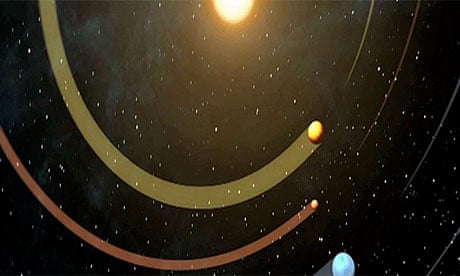Astronomers announced yesterday that one in six stars in the Milky Way – or 17% – host an Earth-sized planet in their solar system that has an orbit of 85 Earth days or less.
The announcement, made at the 221st American Astronomical Society meeting in California, means that there are an estimated 17 billion Earth-sized worlds in this galaxy alone, and probably more circling in larger orbits that haven't been spotted yet.
The NASA Kepler space-telescope team revealed the discovery of 461 new candidate planets, putting the total number identified by the Kepler telescope at 2,740.
Four of the possible new planets are smaller than twice the size of the Earth and orbit within a habitable zone around their suns, meaning liquid water may theoretically exist on their surfaces.
As well as the discovery that 17% of all stars possess an "exo-Earth" (a planet ranging from 0.8 to 1.25 times the size of Earth) in an orbit of 85 Earth days or less, the study found that about one in four stars have a "super-Earth" (1.25 to 2 times the size of the Earth) in an orbit of 150 Earth days or less.
About one in four stars also have a "mini Neptune" (2 to 4 times the size of Earth) in an orbit of 250 Earth days or less, 3 per cent have a "large Neptune" (4 to 6 times the size of Earth) and 5 per cent have a "gas giant" (ranging from 6 to 22 times the size of Earth) in an orbit of 400 Earth days or less.
However, being a similar size to Earth does not necessarily make a planet habitable. The star in our own solar system contains two Earth-size worlds – Earth and Venus – but Venus has a surface temperature of over 400 degrees C and a thick atmosphere of carbon dioxide, which is poisonous to humans in high concentrations.
For a planet to potentially sustain life, it must lie within the "Goldilocks zone", which is a region around a star where a planet with the right atmospheric pressure and surface temperature may theoretically be able to harbour liquid water on its surface.
According to NASA's Exoplanet Archive, it appears they are particularly interested in planets that have a predicted surface temperature of 200-300 Kelvin, and a radius between 1 and 2 times the size of the Earth.
The animation below is a visualisation from February 2012 of the 1,236 exoplanet candidates that had been identified by the Kepler telescope at the time. It was created by Jer Thorp, and you can read more on the topic here.
The two highlighted candidate planets are KOI 326.01 and KOI 314.02. At the time of the animation being created, these two candidates were thought to have the strongest probability of matching some of the habitability requirements that astronomers are particularly interested in.
You can download the full list of 2,740 new candidates, including their ID, orbit, radius and equilibrium temperature, using the link below.
Download the data
DATA: download the full spreadsheet
More data
Data journalism and data visualisations from the Guardian
World government data
Search the world's government data with our gateway
Development and aid data
Search the world's global development data with our gateway
Can you do something with this data?
Flickr Please post your visualisations and mash-ups on our Flickr group
Contact us at data@guardian.co.uk

Comments (…)
Sign in or create your Guardian account to join the discussion